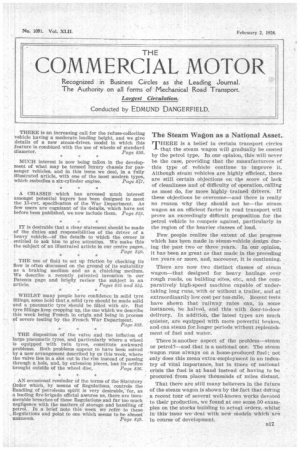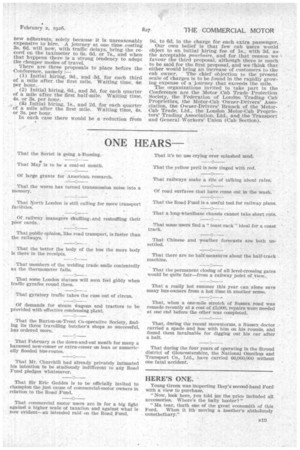The Steam Wagon as a National Asset.
Page 1

Page 2

Page 3

If you've noticed an error in this article please click here to report it so we can fix it.
THERE is a belief in certain transport circles that the steam wagon will gradually be ousted by the petrol type. In our opinion, this will never be the case, providing that the manufacturers of this type of vehicle continue to improve it. Although steam vehicles are highly efficient, there are still certain objections on the score of lack of cleanliness and of difficulty of operation, calling as most do, for more highly trained drivers. If these objections be overcome—and there is really no reason why they should not be—the steam wagon as an efficient factor in road transport will prove an exceedingly difficult proposition for the petrol vehicle to compete against, particularly in the region of the heavier classes of load.
Few people realize the extent of the progress which has been made in steam-vehicle design during the past two or three years. In our opinion, it has been as great as that made in the preceding ten years or more, and, moreover, it is continuing.
There are now two distinct classes of steam wagon—that designed for heavy haulage over rough roads, on building sites, etc., and the comparatively high-speed machine capable of' undertaking long runs, with or without a trailer, and at extraordinarily low cost per ton-mile. Recent tests have shown that railway rates can, in some instances, be halved, and this with door-to-door delivery. In addition, the latest types are much quieter, are equipped with more powerful brakes, and can steam for longer periods without replenishment of fuel and water.
There is another aspect of the problem—steam or petrol?—and that is a national one. The steam • wagon runs always on a home-produced fuel ; not only does this mean extra employment in an industry of vital importance, but in times of national crisis the fuel is at hand instead of having to be procured from places thOusands of miles distant.
That there are still many believers in the future of the steam wagon is shown by the fact that ddring a recent tour of several well-known works devoted to their production, we found at one some 50 examples on the stocks building to actual orders, -whilst In thisissue wedeal With new Models which are In course of development.
The Chancellor Hints at a Raid on the Road Fund.
THE worst fears of the road transport community and of highway authorities were evidently justified and the Road Fund is to be raided by the Chancellor of the Exchequer and the moneys so obtained are to be devoted to pur poses other than roads. The Chancellor was waited upon last week by a large and influential deputation, representing associations of local authorities, for the purpose of stating their case against propcoals to divert any portion of the revenue of the Fund to purposes other than the maintenance, improvement and construction of roads. The deputation represented the Municipal Corporations Association, the County Councils Association, the Urban District Councils Association, the Rural District Couacils Association, the Scottish County Councils Association and the Convention of Royal Burghs. The Chancellor, in his reply, claimed the right of the Government and Parliament to review from time to time any previous arrangement, and he did not accept the view that the Government were debarred in perpetuity from reviewing the ex penditure upon roads .or that in no circumstances whatever could any part of.the proceeds of motor taxation be diverted from road purposes. He agreed that the road system of the country must be maintained and improved in order to cope with the requirements of modern mechanical transport. He made an ominous remark about the damage caused to the roads by heavy-vehicles, saying that this was clearly a subject which called for • examination. He thought that the existing system of taxation was unfair and uneconomic in its inci dence and that ratepayers were in effect subsidizing certain users of road transport, and this in competition with, and at the expense of, the railways, which were themselves among the largest ratepayers in the country. We had thought that this myth of the contribution of the railways towards local rates had been exploded, but it is evident that light must once again be thrown upon the comparable figures in relation to the share paid by mechanical road transport. There was a hint about the present expenditure upon new road construction, the Chancellor stating that it was necessary to consider whether an undue proportion of our national resources was not being devoted to the pur.pose. In this matter he was paying insufficient regard to the fact that, as in other periods of industrial stress, the country is gaining new roads by the expenditure of public money in the provision of employment. The only consolation received by the deputation was the assurance that the Chancellor did not contemplate any diminution of the assistance now given for the upkeep of existing roads, whilst the needs of the rural areas are to receive special consideration. So it is evident that greater economy is to be pursued in respect to new road construction. Heavy transport interests must now gird its loins for a fight upon the incidence of taxation.
A Market which is Ripe for Development.
0 F recent years the marked development of the light van has rather relegated the parcelcar and motorcycle carrier to the background, but those who are au fait with the particular and, in some instances, peculiar circumstances in which each type can profitably and efficiently be employed will, we are sure, readily support the view that there is a useful field of service for each class of transport unit. Those who may be in any doubt on the matter should, first and foremost, remem B18 ber that the requirements of a vast arrarof small and progressive tradesmen call for a carrier of exceedingly small capacity, and quite often from 3 cwt. to 4 cwt. constitutes a maximum load. The smallest four-wheeled van at present on the market deals with goods weighing about double this amount, so that there is obviously plenty of scope for the small carrier, whether it be in the form of a box attachment to an ordinary motorcycle or a special type of three-wheeled machine in which a compartment for goods is disposed fore or aft of the driver. That such vehicles are not in use to a greater extent, particularly amongst small tradesmen, may be due to a variety of causes, but that there is a big market for them no one can gainsay. In this mechanical age the small motorpropelled carrier is an obvious development of the cycle carrier and, in point of carrying capacity, it bridges the gap between this type and the light van. Its simplicity of construction and its high mechanical efficiency do not demand from the youth or man in control the same practical knowledge as that which assists many drivers of heavy Petrol lorries or steam wagons to keep their, vehicles in sound running condition. The method of its control is well within the comprehension of the majority of youths who have ridden an ordinary bicycle or tricycle, and, even by the totally unpractised hand, its operation can be quickly understood. We feel that there is a wide field of use for the small petrol-propelled parcel carrier which hitherto has been only half-heartedly explored and, in so far as the body which it carries can be built to suit the requirements of users in all classes of trade, it must possess limitless poten-tialities. The manufacturers who set themselves out to meet the growing requirements of this market by planning and carrying out a scheme of active propaganda, in which such points as low running cost, ease of maintenance, mechanical reliability and speed are stressed, will reap a profitable and lasting reward for their efforts. The market is there to be cultivated and the passive attitude towards its recognition must go if progress is no longer to be retarded.
An Effort to Attain a Lower* Scale of Cab Fares.
IN a week's time (on Tuesday next) an opportunity will be afforded. the representatives of the cab interests operating in the Metropolis to confer with the Home Office upon the question of cab fares, with a view to a settlement of the discussion which has ranged around the proposal to introduce two-seater cabs. It will be remembered that the Two-seater Taxicab Committee appointed by the Home Secretary definitely averred that there was a need for the revision of fares, and recommended the approval of two-seater cabs. as a means towards such fare revision if the cab trade was not prepared to effect the cut in fares that is demanded and held to be justifiable. Unquestionably there has been a material reduction in operating costs during the past three .years. The price of petrol is not so unreasonable, 'and the life of tyres, owing to improvements in the manufacture of the tyres and in the character of road surfaces, has-been lengthened, whilst many cabs, inefficient and unduly costly to operate, have been replaced. Revenue is increased by traffic congestion, for a journey that under normal traffic conditions would occupy fifteen minutes now invariably takes from twenty to twenty-five minutes, so that the proportion of idle time, other circumstances remaining unaltered, has been diminished. However, it is an undoubted fact that the cab has somewhat lost favour as a means of transport, even among its habitu6s, and it has failed to gain
new adherents, solely because it is unreasonably expensive to hire. A journey at one time 'costing 3s. 6d. will now, with traffic delays, bring the record on the taximeter to 6s. 6d. or 7s., and when that happens there is a strong tendency to adopt the cheaper modes of travel.
There are three proposals to place before the Conference, namely : (1) Initial hiring, 9d., and 3d. for each third of a mile after. the first Mile. Waiting time, 4m per hour.
(2) Initial hiring, 6d., and 3d, for each quarter of a mile after the first half-mile. Waiting time, 45. or 3s. per hour. (34 Initial hiring, 1s., and 2d. for each quarter ' of, a mile after the first mile. 'Waiting time, 4s. or 3s. per hour. .
In each case there would be a reduction from 9d.. to 6d. in the charge for each extra passenger.
Our own belief is that few cab nsers would object to an initial hiring fee of 1s., with 3d. as the acceptable pourboire, and for that reason we ; favour the third proposal, although there is much to be said for the first proposal,.and we think that either would bring an increase of customers to the cab owner. The chief objection to the present scale of charges is to be found in the rapidly growing expense of a journey that exceeds the mile. The organizations invited to take part in the Conferenceare the Motor Cab Trade Protection Society,. the Federation of Londbn TradingCab
• Proprietbrs, the Motor-Cab "Owner-Drivers' Association, the Owner-Drivers" Branch of the MotorCab Trade, Ltd., the London Motor-Cab Proprietors' Trading Association, Ltd., and the Transport and General Workers' Union (Cab Section).






























